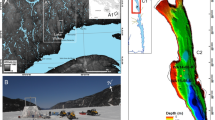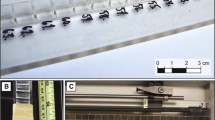Abstract
Varves from many environments have been used as paleoclimatic indicators. Measurement of varve thicknesses has typically been done manually, but an automated procedure would provide more accurate measurements with considerable savings in time. An automated method described herein involves digitizing an x ray of the core with a high-resolution optical densitometer. The two-dimensional optical density field is filtered to enhance the varve signal, and the filtered series is then used to define a series of line segments representing varve boundaries. The distance between adjacent boundaries is then averaged across the core to obtain the mean thickness of each layer. A section of thin laminae from near the bottom of a long core from the Gulf of California (Deep Sea Drilling Project Hole 480) is analyzed to illustrate the technique.
Similar content being viewed by others
References
Anderson, R. Y. and Kirkland, D. W., 1960, Origin, varves and cycles of Jurassic Lodilto Formation: Bull. Amer. Assoc. Petrol. Geol., v. 44, p. 37–52.
Anderson, R. Y. and Koopmans, L. H., 1963, Harmonic analysis of varve time-series: Jour. Geophys. Res., v. 68, p. 877–893.
Anderson, R. Y. and Koopmans, L. H., 1968, Statistical analysis of the Rita Blanca varve time series,in Anderson, R. Y. and Koopmans, L. H. (Eds.) Paleoecology of an early Pleistocene lake on the high plains of Mexico: Geol. Soc. Amer. Mem., v. 113, p. 59–75.
Antevs, E., 1951, Glacial clays in Steep Rock Lake, Ontario, Canada: Bull. Geol. Soc. Amer., v. 62, p. 1223–1262.
Bradley, W. H., 1931, Non-glacial marine varves: Amer. J. Sci., v. 222, p. 318–330.
Brillinger, D. R., 1970, The frequency analysis of relations between stationary spatial series:in Pyke, R. (Ed.), Proceedings of the 12th biennial seminar on time series, stochastic processes, converity combinations: Canadian Mathematical Congress, Montreal, p. 39–81.
Brillinger, D. R., 1975, Time series: Data analysis and theory: Holt, Rinehart, and Winston, New York, 460 p.
Bryson, R. A. and Dutton, R. A., 1961, Some aspects of the variance spectra of tree rings and varves: Ann. N. Y. Acad. Sci., v. 95, p. 580–604.
Byrne, R., Michaelsen, J., and Soutar, A., 1977, Fossil charcoal as a measure of wildfire frequency in Southern California: a preliminary analysis:in Mooney, H. A. and Conrad, C. E. (Eds.) Proceedings of the symposium on the environmental consequences of fire and fuel management in Mediterranean ecosystems: U.S. Forest Service, Washington, D.C., p. 361–367.
Calvert, S. E., 1964, Factors affecting distribution of laminated diatomaceous sediments in Gulf of California,in Marine geology of the Gulf of California, a symposium: Amer. Assoc. Petrol. Geol. Mem., v. 3, p. 311–330.
Calvert, S. E., 1966, Origin of diatom-rich, varved sediments from Gulf of California: Jour. Geol., v. 74, p. 546–565.
Duff, P., McL., D., Hallam, A., and Walton, E. K., 1967, Cyclic sedimentation: Elsevier, New York, p. 49–60.
Hawkins, D. M. and Merriam, D. F., 1973, Optimal zonation of digitized sequential data: Jour. Math. Geol., v. 5, p. 389–395.
Hulsemann, J. and Emery, K. O., 1961, Stratification in recent sediments of Santa Barbara Basin as controlled by organism and water character: J. Int. Assoc. Math. Geol., v. 69, p. 279–290.
Kulinkvich, A. Y., Sokranov, N. N., and Churinova, I. M., 1966, Utilization of digital computers to distinguish boundaries of beds and identify sandstones from electric log data: Int. Geol. Rev., v. 8, p. 416–420.
Soutar, A. and Crill, P. A., 1977, Sedimentation and climatic patterns in the Santa Barbara Basin during the 19th and 20th centuries: Geol. Soc. Amer. Bull., v. 88, p. 1161–1172.
Soutar, A. and Isaacs, J. D., 1974, Abundance of pelagic fish during the 19th and 20th centuries as recorded in anaerobic sediment off the Californias: Fish. Bull., v. 72, p. 257–273.
Tukey, J. W., 1967, An introduction to the calculations of numerical spectrum analysis: Proceedings of advanced seminar on spectral analysis of time series, Madison, Wisconsin: John Wiley & Sons, New York, p. 25–46.
Van Houten, F. B., 1962, Cyclic sedimentation and the origin of analcime-rich Upper Triassic Lockatong Formation, west-central New Jersey and adjacent Pennsylvania: Amer. J. Sci., v. 260, p. 561–576.
Author information
Authors and Affiliations
Rights and permissions
About this article
Cite this article
Michaelsen, J. An automated method for measuring thicknesses of layered sediments. Mathematical Geology 17, 729–742 (1985). https://doi.org/10.1007/BF01031613
Received:
Accepted:
Issue Date:
DOI: https://doi.org/10.1007/BF01031613




